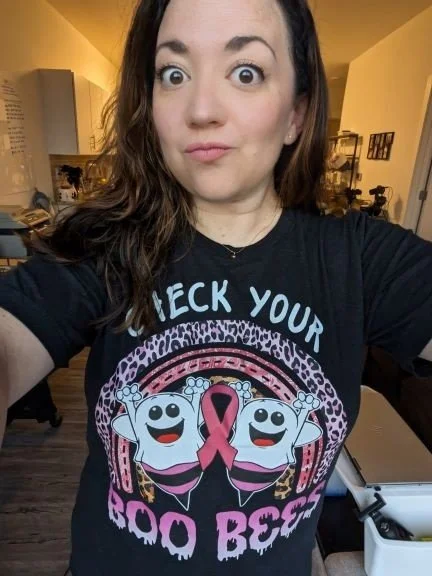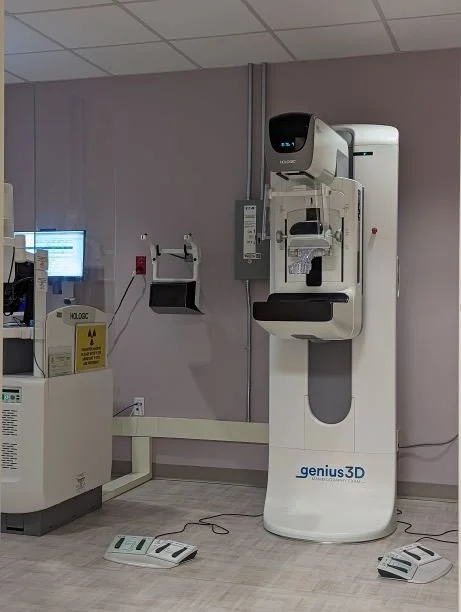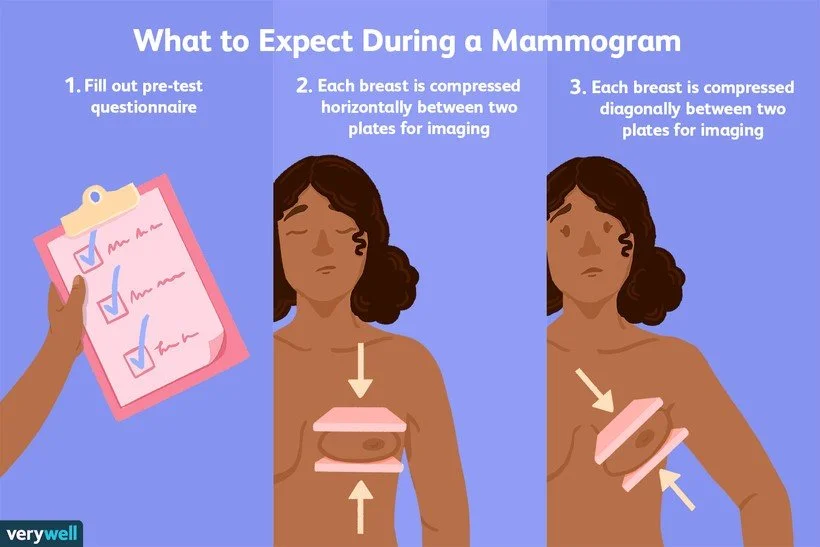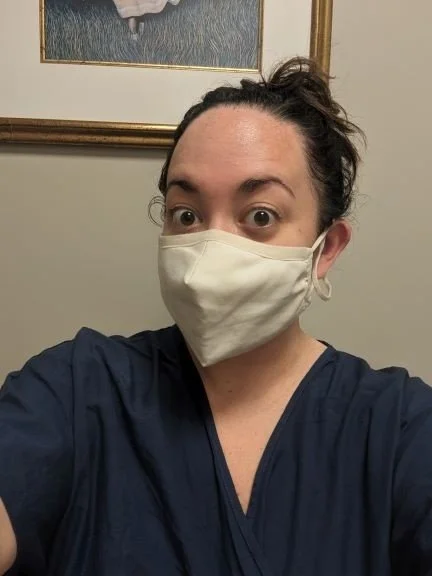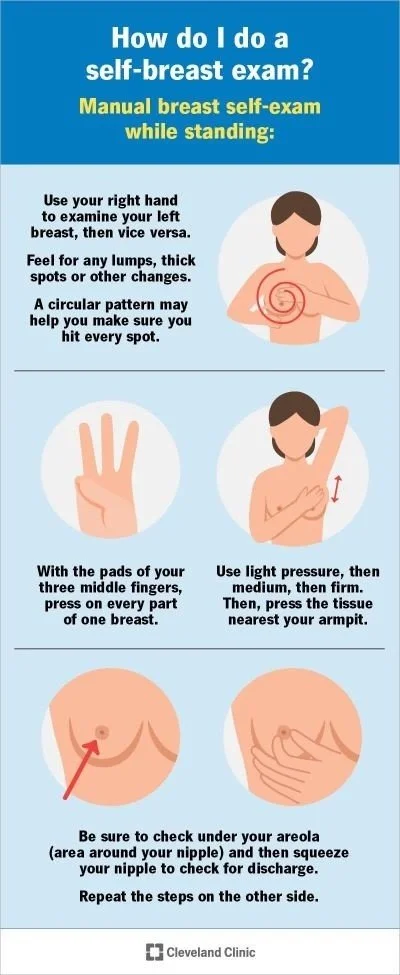Check Your Boo Bees!
*FYI- illustrations of mammograms/breast exams, including illustrations of bare breasts in the blog below.*
It's pink EVERYTHING season. This year's Breast Cancer Awareness Month is a special one for me, because this year I turned 40, and that's the age that the CDC and many medical professionals recommend women begin getting mammograms. After knowing so many folks who have battled cancer, I had been talking to my doctor for several months about our game plan, and I ended up getting my first mammogram less than a week after my 40th birthday.
I know that growing up, I heard so many women talk about dreading getting their mammograms, and it's been a source of dread for a lot of us, so I definitely felt some nerves. In case you're feeling them too, I wanted to take the time to talk about my experience and hopefully give you an idea of what to expect.
I highly recommend wearing a punny shirt to help check your nerves. ;)
When you schedule your appointment, they'll tell you you can't wear any deodorant or lotion on your breast area or under your arms. This is because the residue from those sort of products can show up on the images as anomalies. They'll also suggest you avoid caffeine for a few days, and that you should schedule your appointment according to your menstrual cycle. In other words, they're trying to help you avoid as much discomfort as possible during your procedure.
The day of your appointment, you should wear separates. After you check in, you'll be escorted to a changing room, where you're asked to undress (everything above the waist- hence why you want to wear separates, so you don't have your bare butt out. It's cold in there!), and you'll put on a hospital gown that opens in the front. Small jewelry is ok to leave on as long as it's not in the way during the test. I'd advise just skipping the jewelry or leaving it with your clothes in the changing room.
After you've got your gown on, you'll go into the exam room, where you'll chat with the technician for a moment to verify your information and to talk about what to expect. Then you'll step up to the mammogram machine (which is not nearly as scary as I expected- I thought it'd be more like an MRI!). The technician will ask you to take one arm (and boob) out of your robe, and they'll position you how they need you to stand, and they'll position your breast on a plate on the machine, then move a second plate to press down on top of the breast. You'll feel a bit of pressure at this point, but it shouldn't be painful.
The mammogram exam room at my local breast imaging center
You'll take a deep breath and hold your breath as the technician presses a button to activate the machine- it's basically like any other kind of x-ray where you just hold really still for a few seconds while the machine does its thing, and then they reposition you for additional images. During that first mammogram, the technician took two images of one breast, then moved me a little bit to take two more in a different position, and then repeated the process for the other breast. Total, about eight images were taken.
Infographic about what to expect, borrowed from VeryWell
The technician will then review the images to be sure they are clear enough for analysis, and discuss with you what to expect next. Something I was so grateful they mentioned to me was that for many people, they will be called back for more images after their first mammogram. They told me that was perfectly normal, and the reason is that normally after your annual mammogram, they compare the images to your previous ones, to be sure there's nothing new or weird. After your first visit, they don't have those original images for comparison, so they sometimes want to take more images just to be extra cautious. That was the case for me.
I was asked to come back a week later, and this appointment was a little more in depth. The process overall was the same, though the mammogram required a few more awkward positions and a bit more pressure from the machine. It still wasn't painful, and the technician frequently checked in with my comfort level and let me know if ever it was painful, they could adjust somewhat. (On that note- *always* speak up and advocate for yourself in your medical experiences- no one knows what you're feeling better than you, and even if it's not possible for the medical professionals to completely avoid causing any discomfort, you won't know unless you say something.)
Waiting while the tech & doctor reviewed my images.
At this second appointment, the images were reviewed by a doctor while I waited, and then they determined it was necessary for additional images- this time by ultrasound. I was escorted to a room down the hall and the doctor joined us. The ultrasound was exactly what you'd think- dark room, cold lube, and someone rubbing a magic wand over your boobs and looking at the images on a screen. This was the part that took the longest out of this whole process. Each mammogram takes only about five to ten minutes, and the ultrasound took probably twenty to thirty. It wasn't uncomfortable at all, other than being kind of awkward.
Again, the doctor reviewed the images and the ultrasound and let me know even before I left that they didn't see anything troubling. They explained why they wanted the additional images, what they were looking for, and let me know that I'll need to come back in six months for a follow up, just to be sure everything looks normal.
Overall, the experience was painless, easy, and empowering to know that I've taken control of my health and my future. It was comforting to know I've built relationships with my healthcare team to stay on top of things and hopefully stay healthy for years to come.
Before I wrap up, I wanted to mention a few things about breast cancer and mammograms that I feel are important to share.
First- not just cis women get breast cancer and not just cis women should get mammograms. Sometimes cis men need them, and often trans people do, too. So regardless of your gender, please talk to your doctor about what's best for you.
According to Susan G. Komen, only about 4% of people under 40 get breast cancer. But once you reach that age, rates increase, and are highest in women over 70. About 1 out of every 8 women will be diagnosed with breast cancer in their lifetime. When caught early, the 5-year survival rate is about 99% for localized breast cancer and about 90% for invasive. So definitely don't put off those mammograms, and be sure you're doing your monthly self-exams!
Breast self-exam instructions from Cleveland Clinic
Organizations like the National Breast Cancer Foundation (a 4-star Charity Navigator org.) are a great asset for learning about the disease and finding resources about how to prevent it, detect it, and treat it. I'm proud to announce that ALL of our Patreon funds will be donated to the NBCF this October. If you feel so inclined, I'd also like to make a gentle plea to consider donating to them in the future as well. More info about them can be found at: www.nationalbreastcancer.org.

